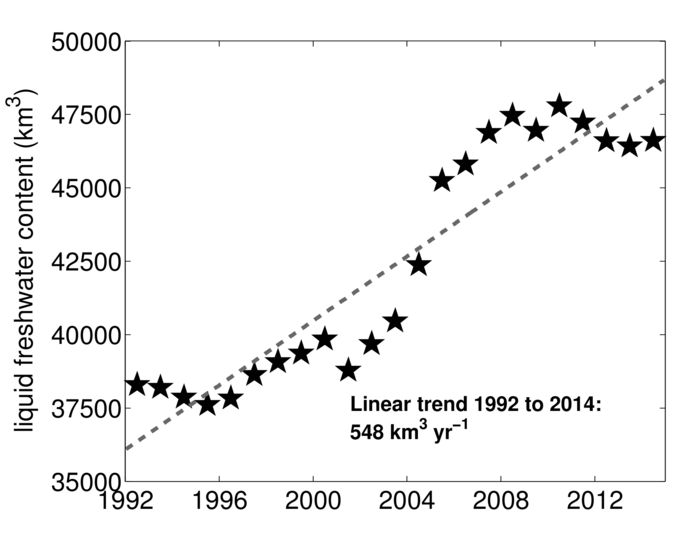Page path:
- Home
- Research
- Ocean and Climate
- Projects & Collaborative Groups
- RACE
- Theme 2
- WP 2.1: Changes in the circulation of fresh water between Arctic Ocean and subpolar North Atlantic
WP 2.1: Changes in the circulation of fresh water between Arctic Ocean and subpolar North Atlantic
PIs:
Benjamin Rabe, AWI Bremerhaven, Benjamin.Rabe(at)awi.de
Rüdiger Gerdes, AWI Bremerhaven, Ruediger.Gerdes(at)awi.de
Team:
Ursula Schauer, AWI Bremerhaven
Myriel Horn, AWI Bremerhaven
Tamas Kovacs, AWI Bremerhaven
Benjamin Rabe, AWI Bremerhaven, Benjamin.Rabe(at)awi.de
Rüdiger Gerdes, AWI Bremerhaven, Ruediger.Gerdes(at)awi.de
Team:
Ursula Schauer, AWI Bremerhaven
Myriel Horn, AWI Bremerhaven
Tamas Kovacs, AWI Bremerhaven

Annual mean fresh water content in the upper layers of the Arctic Ocean from an analyses of salinity data (update of the time series in Rabe et al., 2014; GRL). The calculation was done relative to the salinity of the inflowing Atlantic Water.
The exchange of water masses between the Arctic Ocean and the subpolar North Atlantic impacts both oceans and climate. Changes in the freshwater export from the Arctic influence the stability and circulation in the North Atlantic, with potential effects on deep water formation, overturning and sea level.
Observations and model simulations, including those within RACE, have shown a strong increase in liquid freshwater in the Arctic Ocean in recent decades. Model simulation indicate that this strong increase is a reaction to a positive phase of a multidecadal oscillation, which could be followed by high export in the coming years.
The mechanisms underlying these oscillations have not yet been sufficiently understood. In addition to changes in continental runoff and melt-freeze budgets of sea-ice in the Arctic links of freshwater changes in the Arctic and North Atlantic with the atmospheric circulation and reduced southward freshwater transport have been discussed.
The Modini model system that allows prescription of wind stresses for ocean and sea ice in an otherwise fully coupled Earth system model will be used to conduct several scenario experiments with different wind stress situations, e.g. a prolonged negative NAO situation ended by an abrupt transition to the positive state. The Modini system is very flexible and further experiments will be conducted.
Key questions:
Observations and model simulations, including those within RACE, have shown a strong increase in liquid freshwater in the Arctic Ocean in recent decades. Model simulation indicate that this strong increase is a reaction to a positive phase of a multidecadal oscillation, which could be followed by high export in the coming years.
The mechanisms underlying these oscillations have not yet been sufficiently understood. In addition to changes in continental runoff and melt-freeze budgets of sea-ice in the Arctic links of freshwater changes in the Arctic and North Atlantic with the atmospheric circulation and reduced southward freshwater transport have been discussed.
The Modini model system that allows prescription of wind stresses for ocean and sea ice in an otherwise fully coupled Earth system model will be used to conduct several scenario experiments with different wind stress situations, e.g. a prolonged negative NAO situation ended by an abrupt transition to the positive state. The Modini system is very flexible and further experiments will be conducted.
Key questions:
- In the light of expected changes in sea ice, atmospheric circulation and
continental runoff, how will the freshwater content in the Arctic Ocean develop? - What are the mechanisms connecting freshwater budgets in the Arctic Ocean,
the Nordic Seas and the North Atlantic?
The analysis of observations, atmospheric reanalysis data and model simulations will focus on meridiional freshwater transports, atmospheric coupling and freshwater content from the North Atlantic to the Arctic.


